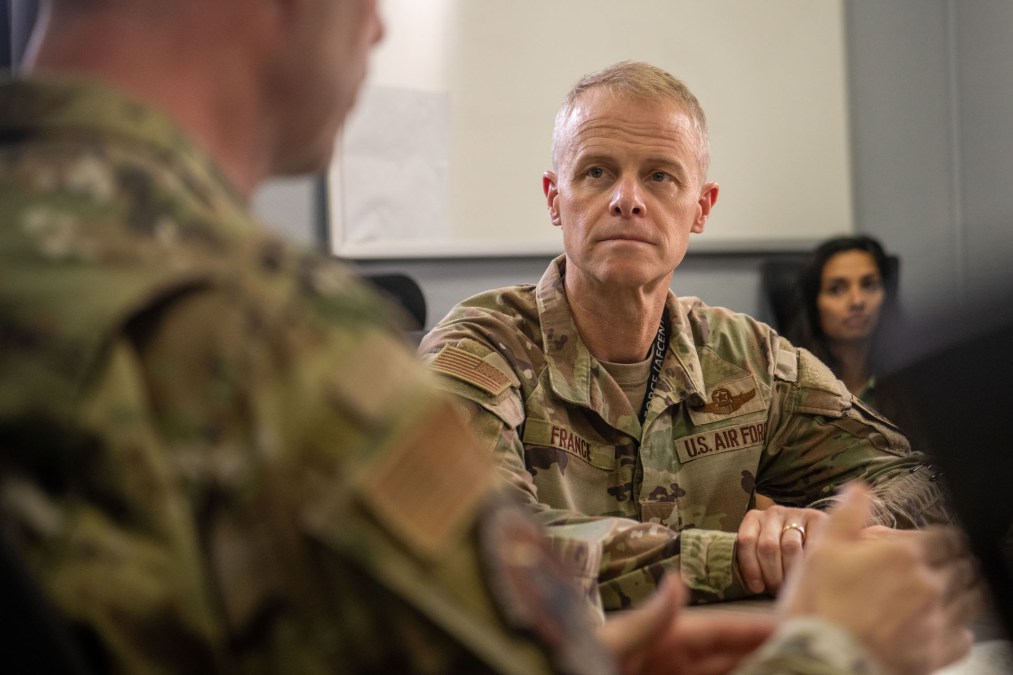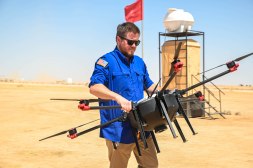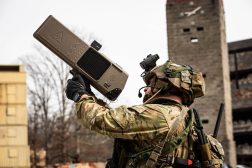AFCENT moving to compete in ‘the numbers game’ with low-cost drones

NATIONAL HARBOR, Md. — As they hustle to accelerate the adoption of next-generation weapons amid real-world conflicts unfolding across the Middle East, the U.S. military’s existing and emerging innovation teams there are focused on delivering small, low-cost drones and systems to defeat those types of threats.
Lt. Gen. Derek France, commander of Air Forces Central and the combined forces air component commander for U.S. Central Command, briefed reporters on those and other near-term plans during AFA’s Air, Space and Cyber conference last week.
“I am very confident in the ability for us, right now, to repel an attack from drones or ballistic missiles [from Iran or other adversaries]. There comes a degree that the thing that causes concern is the numbers game — as drones, specifically, are cheap to make in large numbers — that becomes a challenge when you’re exclusively playing defense against them,” France said at a media roundtable. “It just becomes a game of numbers over time.”
France has led AFCENT since April 2024. The command is rotational in nature, with about 10,000 personnel who rotate through the Middle East at any one time, he noted.
Top priorities in that area of responsibility include deterring Iran and its proxies, competing with China, and supporting counterterrorism activities. France said some of his distinct operational focus areas involve maintaining resilient command and control structures and enabling integrated air-and-missile defense for the U.S. and its partners there.
“This is an important aspect of what we do in that theater [so] that we’re ready to execute major combat operations when tasked to do so,” France said.
Operation Midnight Hammer against Iranian nuclear facilities marked one of the most recent, high-stakes missions his team helped facilitate. AFCENT also played a key role in the U.S. military’s campaign against the Iran-backed Houthis that sought to disrupt global shipping routes in the Red Sea to protest Israel’s war in Gaza.
“My assessment is the Houthis have no interest in attacking U.S. forces [now], because they know what’s up,” France said. “They’re interested in keeping that ceasefire with us. Clearly, they have capability to target Israel. We see ballistic missile shots, we see other things that happen … but they are savvy enough to know the difference between those two.”
He declined to speculate about whether American forces might have to step up and defend against the rebel group again in the months to come.
“As far as what the future holds, I won’t make a guess on whether or not we will have to go back in. I do think the Houthis are going to be a problem that isn’t going to go away necessarily on its own. And I don’t assess that, if the Gaza conflict is settled — it’s not like they’ll just all of a sudden become our best friends. I think that they will use that conflict right now to validate their own interests within Yemen and, if that were to go away, they’ll need something else that they can anchor on to validate their own legitimacy and interest,” France said.
U.S. service members have been simultaneously moving to adopt and refine advanced warfighting capabilities in those real-world combat scenarios, and against this backdrop of numerous evolving threats. Last week, Centcom unveiled plans to launch a Rapid Employment Joint Task Force that will oversee a push to supply military personnel with new capabilities in a rapid timeframe of 60 days or less.
“We have an organization that aligns with that called Task Force 99 — and that’s an innovation task force underneath AFCENT — charged with looking at innovative ways to look at tough problem sets. Specifically, right now, they’re focused on small, attritable [uncrewed aerial systems], something that can can provide, you know, lower-fidelity ISR, but in a way that’s attritable and cheap,” France told DefenseScoop, using an acronym to refer to intelligence, surveillance and reconnaissance.
While there are exquisite drone capabilities across the Defense Department’s arsenal, he noted that “this is a way to get after a rapidly-changing ability to do that, and it aligns very well underneath” Centcom’s new joint task force.
“So, Task Force 99 is a unique organization in AFCENT in that it brings together everything from acquisition [experts], scientists, special operators — all people that are trained, and it’s in their DNA to look at problem sets differently — and you throw those people in a jar, and you shake them up, and it’s interesting what comes out on the other side,” France said.






